A young woman turns her gaze upward and from her half-open mouth seems to emit a sound, a song; her sweet, delicate face has the rosy tones of childhood. Her straight blond hair is gathered and wrapped in a soft luxurious turban, as sumptuous and rich in drapery is the gown she wears the color of gold, and from her shoulders on her pale arms falls a mantle in orange tones decorated with golden motifs. Her smooth, delicate hands rest on a book that she holds open almost at a right angle on a sort of plinth, and with her left hand she also clutches a white scroll. From behind that plinth rises erect the handle of a viola. The girl is in an interior, leaning just below an opening to the outside from which the blue of the sky and the green of the laurel leaves can be seen, while on the wall in the foreground, next to the young woman, a vine grows. This is how the viewer is shown the famous Cumaean Sibyl depicted by Domenichino (Bologna, 1581 - Naples, 1641).
Certainly, as the master of seventeenth-century classicism that he was, the depiction of the sibyl was a theme dear to the Bolognese Domenico Zampieri, since in many cases it was precisely in mythology that the era in which the return to classical themes and culture was fundamental found its inspiration. Mythological characters often cast in a landscape occupied the canvases of the celebrated artist, to which he also gave a unique refinement and delicacy and an almost theatrical stage presence.
Sibyls were young virgins devoted to the god Apollo who could utter oracles, that is, predict the future, although nevertheless the phrases they uttered were somewhat difficult to decipher. In the Greek and Roman mythological world, the term “sibyl” referred to all the prophetesses who enunciated prophecies when possessed by a trance-like state, and since they had spread throughout the Mediterranean, each was distinguished according to the different area.
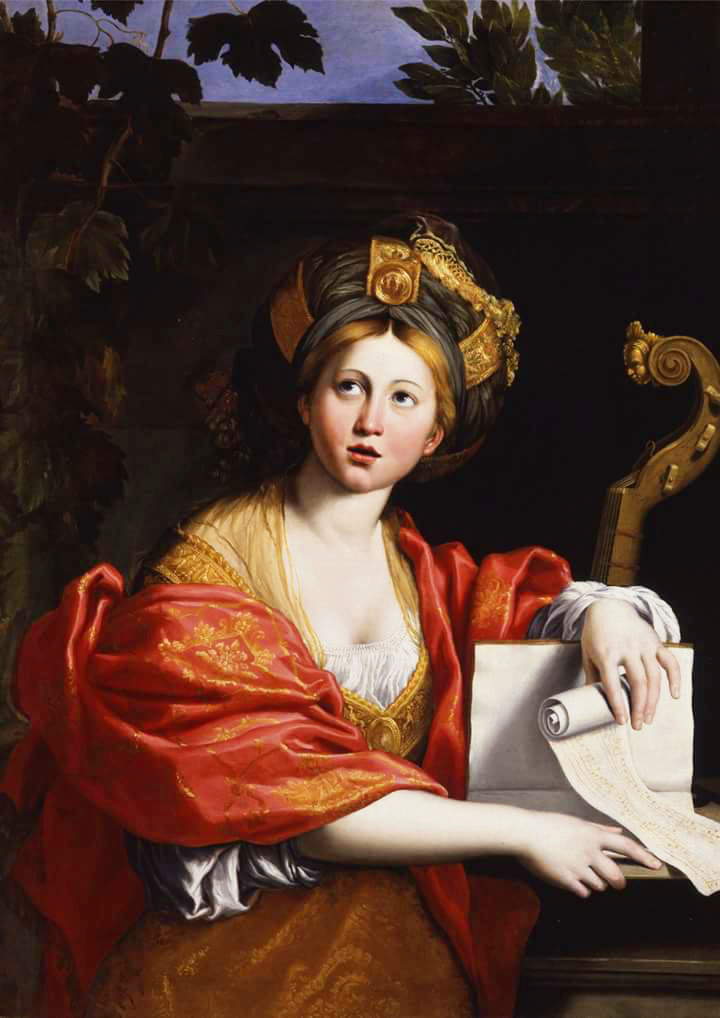 |
| Domenichino, Cumaean Sibyl (1617; oil on canvas, 123 x 89 cm; Rome, Galleria Borghese) |
The Cumaean Sibyl, the one depicted by Domenichino, was the sibyl of the city of Cumae in Campania; daughter of Glaucus, Deiphobe (as she was called) was a priestess of Apollo and Hecate. Falling in love with her, the god Apollo offered her whatever gift she desired: Deiphobe asked him to live as many years as the grains of sand she clutched in her hand, but forgot to ask at the same time to preserve all the freshness of youth; Apollo also granted her this last gift, but in return she had to match his affection: at which point the maiden preferred inviolable chastity to eternal youth. Having therefore become a sibyl, inspired by Apollo, she uttered her oracles from the depths of a cavern in the temple of the deity: from a hundred doors came terrible voices that made the prophetess hear her answers. However, Deiphobe was also a priestess of Hecate, who had entrusted her with the task of guarding the sacred groves of Avernus. It was from here, in fact, that Aeneas had turned to her to descend into the realm of the underworld. By the time of Aeneas, the sibyl had already lived seven hundred years (Virgil in fact introduces her as “the old Virgin Sibyl”) and she still had three hundred years left to live based on the total number of grains she held in her hand at the time of the covenant. In the third book of the Aeneid Virgil relates that the Sibyl of Cumae used to announce her oracles by writing them on leaves and it was necessary to be careful to take those leaves in the same order in which she had left them because otherwise, if the message ended because of the disordered or lost wind, no further response would be received.
The cavern from which the priestess promulgated her prophecies remains to this day suspended between reality and mythology, for indeed this mysterious place can still be visited today: a long, trapezoidal tunnel carved into the rock, with several branches mostly with no exit; in the center is the hall where the sibyl received. Even when her body was worn and devoured by time, reduced to almost nothing, and locked in an ampulla, it was possible to hear only her voice. Virgil himself, in the sixth book of the Aeneid, tells of the meeting between Aeneas and “Deiphobe of Glaucus, a minster of Diana and Apollo” and of the “immense cavern that in the mount penetrates. Avvi d’intorno cento vie, cento porte; e cento voci uscono insieme allor che la sibilla le sue risposte intuona.” And it is there that Aeneas meets his father Anchises, on the threshold of the underworld realm.
However, the question of the true existence of the sibyl remains shrouded in mystery.
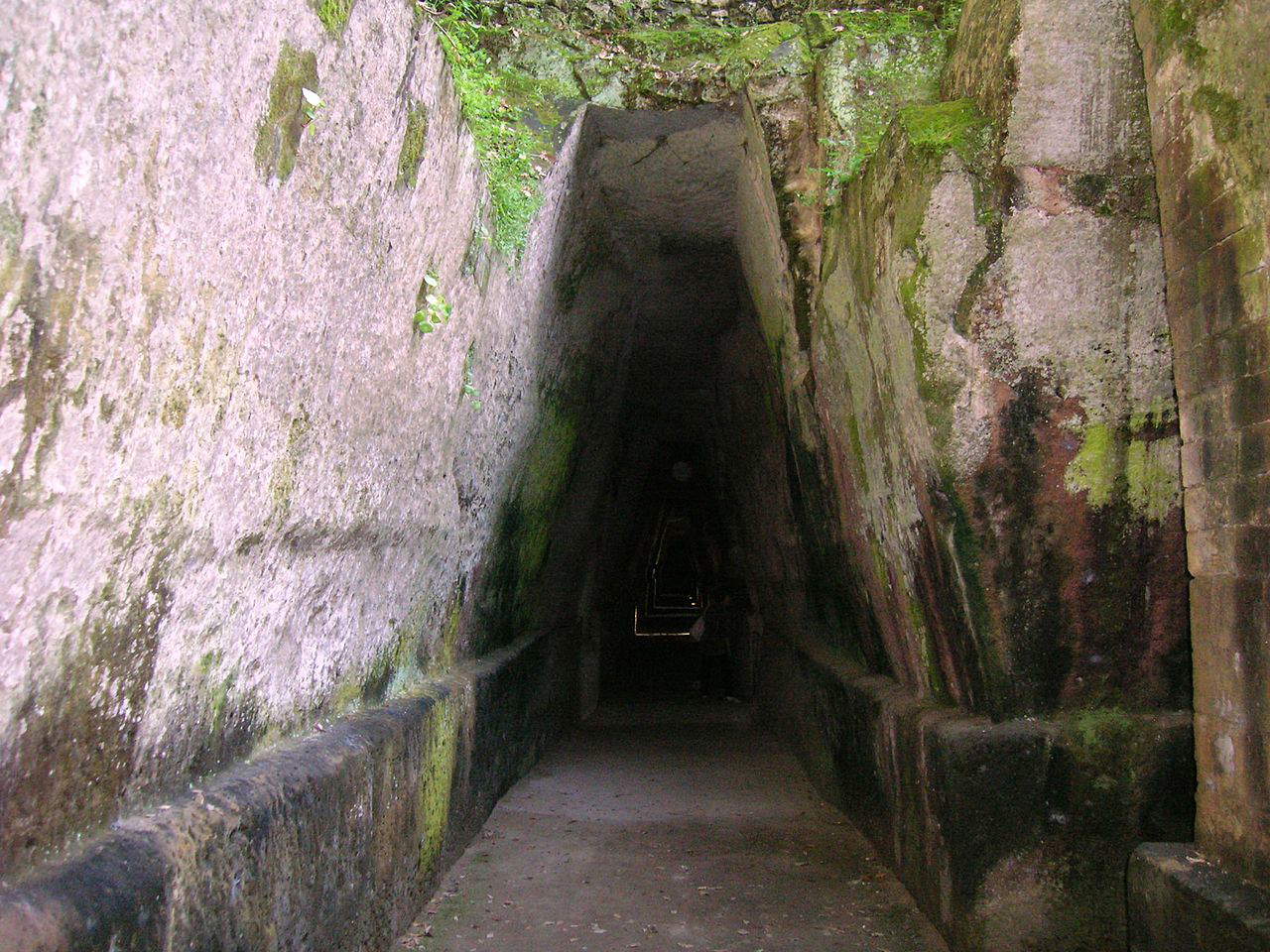 |
| The cavern of the Sibyl at Cumae. Ph. Credit |
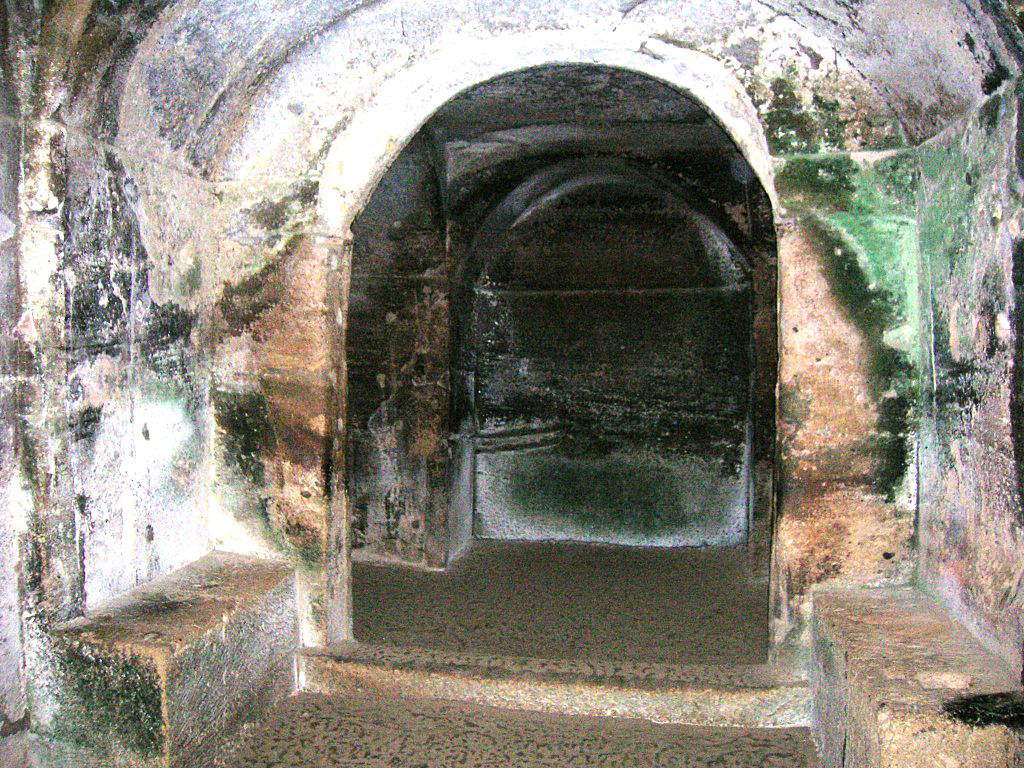 |
| The room of the Sibyl. Ph. Credit |
It is unclear whether the Cumaean Sibyl depicted by Domenichino is in that cavern in the Phlegraean Fields, although it would seem not, given the presence of plants and the sky, but what seems unmistakable is the reference to the god Apollo in various symbols painted in the canvas: the presence of musical instruments (the viola handle) that refers to the deity as protector of the arts and music, the musical notes of a single-voice aria on the scroll, and the laurel plant glimpsed outside (laurel is the plant sacred to Apollo). Domenichino himself had a particular flair for music , of which he possessed both theoretical knowledge, especially the mathematical study of harmony, and practical knowledge; he often surrounded himself with the company of musicians and composers and knew how to play the viola, zither, and lute, also singing madrigals, odes, and other compositions. The concrete knowledge of musical instruments was translated in his paintings into the precise depiction of instruments and scores.
The artist made the famous painting preserved in the Galleria Borghese in Rome in 1617, precisely for Scipione Borghese, the cardinal nephew of Pope Paul V who initiated that intense acquisition of works of art to which we owe his extraordinary collection still admired by thousands of visitors today. That it was accomplished for the cardinal is confirmed by evidence dating from the mid-19th century that places Domenichino’s Sibilla Cumana in the fourth room, along with works by Giulio Romano, Michelangelo, Cavalier d’Arpino, Rubens and Giorgione.
The young woman depicted in the guise of the Sibyl was none other than the painter’s wife , Marsibilia Barbetti, who served as a model in several of the artist’s paintings: her delicate face is found in one of the two “virgins embracing” in the Madonna of the Rosary altarpiece and the Martyrdom of St. Agnes, both in the Pinacoteca Nazionale in Bologna, in St. Catherine of Alexandria, but especially in the Louvre’s St. Cecilia. Similarly to the Cumaean Sibyl,St. Cecilia turns her gaze upward in a kind of musical ecstasy and holds her mouth half-open to emit a chant; she is luxuriously dressed and adorned with jewelry, but unlike the former, she is in the act of playing a viola da gamba, in whose scroll is carved the winged head of an angel, a detail common to the two works. This time, however, the score on which a vocal aria is read is supported by an angel placed in front of the saint. And it should be remembered that the saint is strongly linked to music, as the patron saint of music, instrumentalists and singers. Two works are therefore linked both from a formal and compositional point of view in terms of the appearance of the protagonists, especially in their faces, and from a thematic point of view in terms of the depiction of the musical theme.
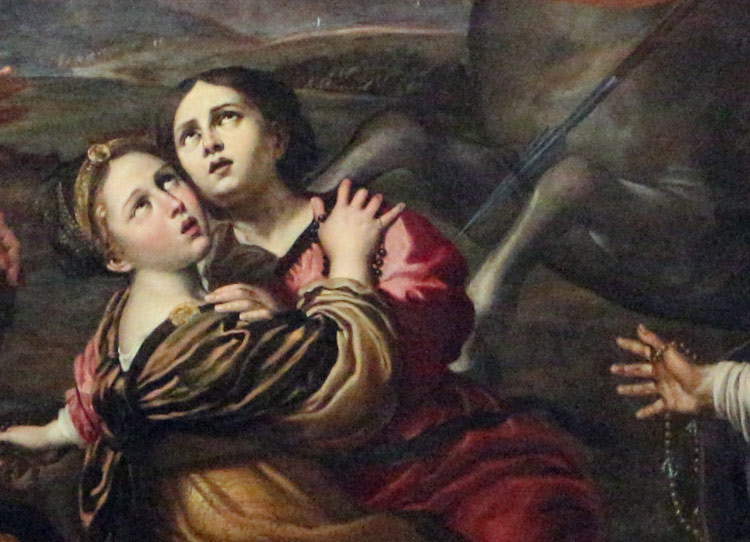 |
| Domenichino, Madonna of the Rosary, detail (1617-1621; oil on canvas, 498 x 289 cm; Bologna, Pinacoteca Nazionale). Ph. Credit Francesco Bini |
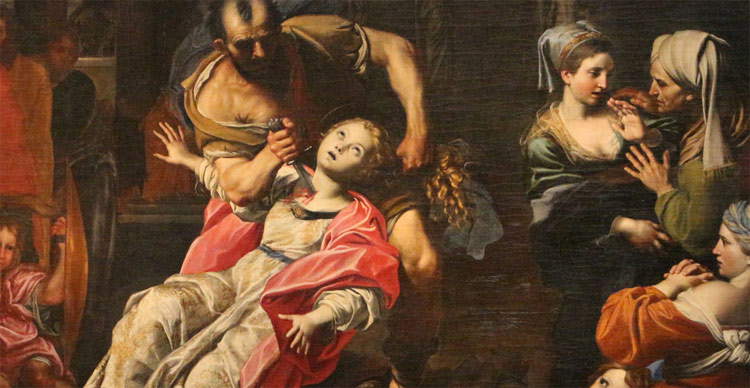 |
| Domenichino, Martyrdom of Saint Agnes, detail (1621-1625; oil on canvas, 533 x 342 cm; Bologna, Pinacoteca Nazionale). Ph. Credit Francesco Bini |
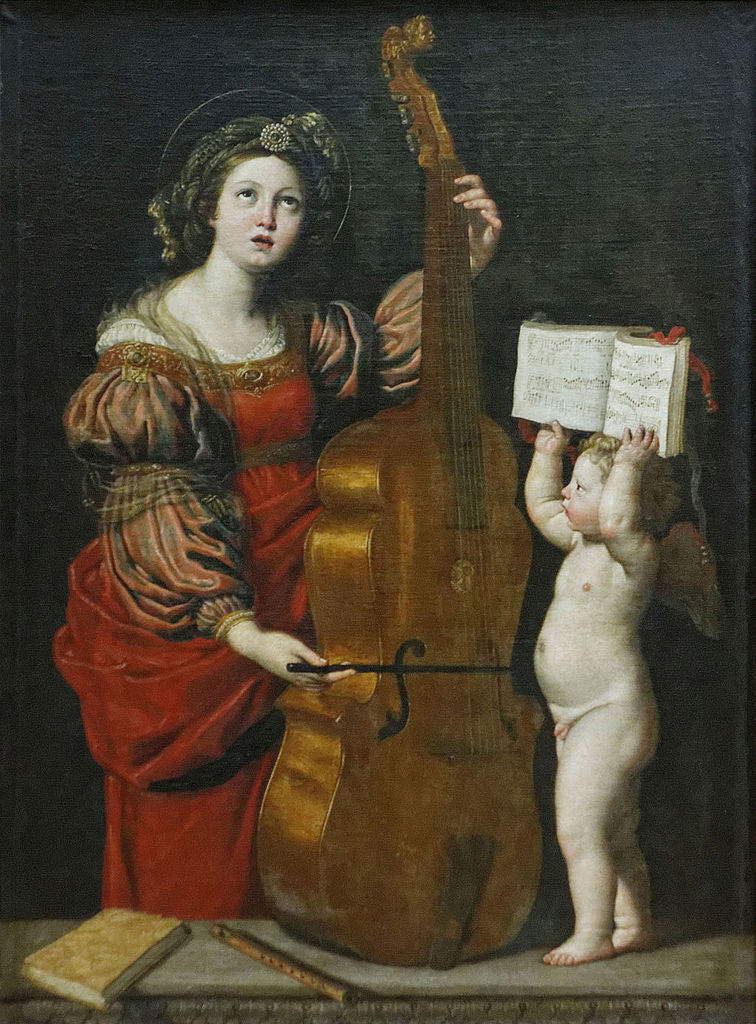 |
| Domenichino, Saint Cecilia (c. 1617; oil on canvas, 160 x 120 cm; Paris, Louvre) |
Although the Cumaean Sibyl housed in the Galleria Borghese is the best known, Domenico Zampieri made three other paintings with the same subject: one is in the Capitoline Museums, another is in the Wallace Collection in London, and another example was rediscovered in the early 1970s and is part of a Scottish private collection.
The Capitoline Museum s canvas made in 1622 appears very similar to the one in the Borghese Gallery: the setting appears to be the same, with the opening outward from which the laurel plant sprouts, a symbol as already stated of the god Apollo; instead of the vine, which in the Borghese one flanked the sibyl, in this case a rich knotted curtain in golden tones descends. The Capitoline Museums’ Sibyl is depicted in the same pose as the other: she is looking upward with her face slightly more in profile and her lips are slightly more half-open. A soft, rich turban encircles her head, from which the priestess’s dark hair can be glimpsed (blond hair, on the other hand, is seen in the Sibyl of the Borghese Gallery); she wears a dangling earring and a golden dress with wide white sleeves, and over her arms a soft red drapery descends. Similarly to the other canvas, she holds in her hands an open book and a scroll: on the latter is an inscription in Greek that translated means “There is one infinite and ungenerated God.” This is a reference to the 4th Egloga in Virgil’s Eclogues in which the arrival of a child who would bring back the golden age is predicted: a prophecy that in a Christian key announced the arrival of Jesus in the world. Symbols of Apollo are also present in the Capitoline Sibyl, such as the laurel and the zither noted behind the woman’s left arm; the viol has been replaced by the zither, an ancient musical instrument typical of the god of music. The work was witnessed in the first half of the eighteenth century in the Roman collection of the Pio family; in 1750 it was given to Pope Benedict XIV, the one to whom we owe the birth of the Pinacoteca Capitolina.
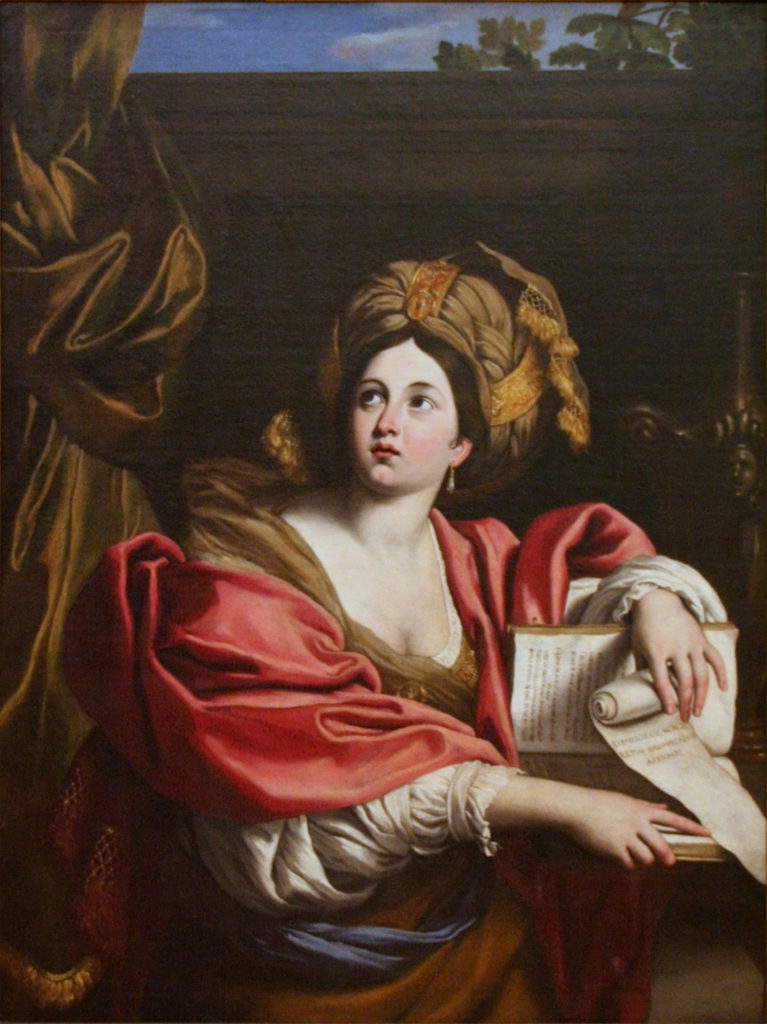 |
| Domenichino, Sibilla Cum ana (1622; oil on canvas, 138 x 103 cm; Rome, Capitoline Museums, Pinacoteca Capitolina) |
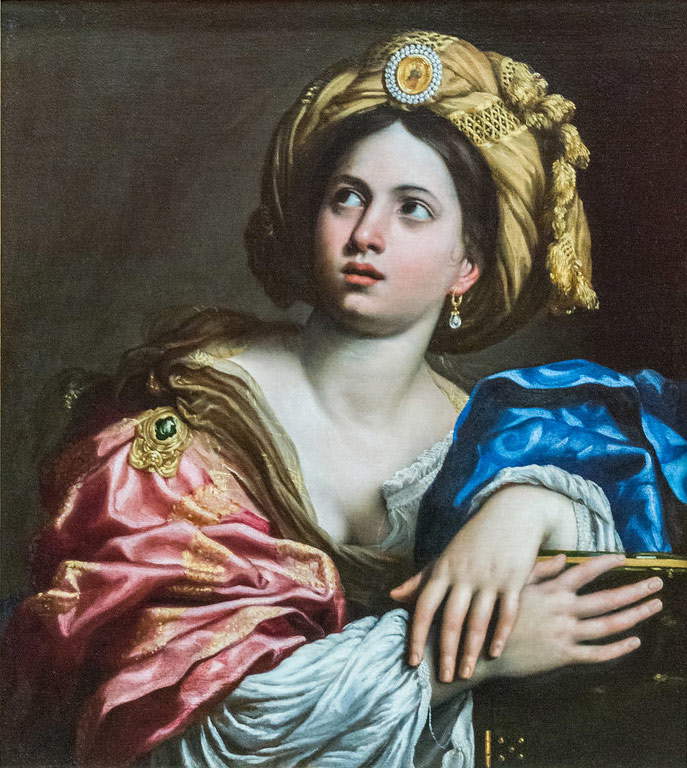 |
| Domenichino, Sibilla Cumana or Sibilla Persica (1620s; oil on canvas, 77.4 x 68.2 cm; London, Wallace Collection) |
The one preserved at the Wallace Collection in London and dated 1613-14 is different from the other two: first, the priestess occupies the entire canvas, thus eliminating references from the setting and even references to the theme of music; in fact, no outward openings, no plants, and no musical instruments are visible. The pose is similar to the Capitoline Sibyl and like the latter has dark hair and wears a dangling earring. Again, the head is wrapped in a rich golden turban on which a diadem is noticeable in the center; the gold-toned dress is embellished with voluminous decorated draperies, one pink and one blue, on the wide white sleeves. Another difference from the other two paintings is the book that she holds closed, resting it on her rib. The female figure depicted has not been considered a Cumaean Sibyl, but rather a Persian Sibyl.
All three of the paintings described, although they have similarities and differences between them, testify to Domenichino’s great pictorial ability, characterized by refinement, composure, and remarkable attention to detail. The decision to depict this character drawn from mythology in several examples fully illustrates how the sibyl was a recurring subject in the period contemporary with him; it also allowed the artist to show other aspects of his knowledge, such as his musical knowledge, and to put his talents in portraiture into practice.
Bibliography
Warning: the translation into English of the original Italian article was created using automatic tools. We undertake to review all articles, but we do not guarantee the total absence of inaccuracies in the translation due to the program. You can find the original by clicking on the ITA button. If you find any mistake,please contact us.